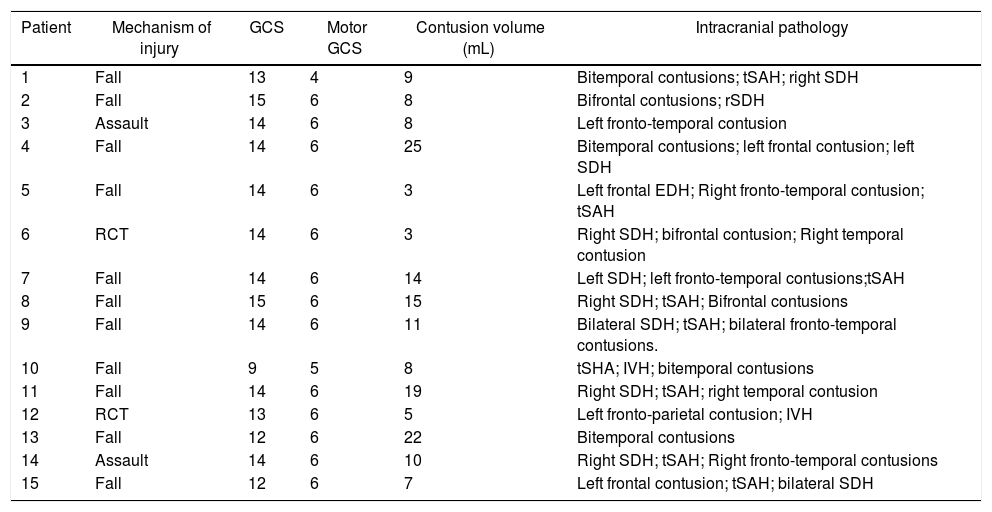Cerebral edema is a frequent and serious complication of traumatic brain injury (TBI). Diffusion tensor imaging (DTI) is considered a useful technique to assess white matter integrity after TBI. The objective of this prospective, observational study was to assess the characteristics of the vasogenic edema in the traumatic pericontusional tissue and compare it to the vasogenic edema found in brain tumors. We also included a control group.
MethodsUsing DTI, the Apparent diffusion coefficient (ADC) and Fractional anisotropy (FA) were measured in the area of vasogenic edema in both TBI and tumor patients. The measurements in the control group were done in the gray and white matter. We included 15 TBI patients, 18 tumor patients and 15 controls.
ResultsADC and FA showed no differences between TBI and tumor patients (p=0.27 for AF; p=0.79 for ADC). Compared to healthy controls, TBI and tumor patients presented higher ADC values and lower FA values. The differences between TBI and controls were statistically significant (p<0.05).
ConclusionsIn this prospective observational study using DTI-MRI in a selected group of mild and moderate TBI patients with vasogenic pericontusional edema we have shown that there were no significant differences of the ADC and FA values compared to brain tumor patients. Furthermore, healthy controls showed significant lower ADC values and higher FA values compared to TBI and tumor patients. Future studies, using DTI-MRI, should address whether any therapy has a favorable impact on the vasogenic edema of TBI patients with brain contusions.
El edema cerebral es una complicación grave y frecuente en pacientes con traumatismo craneoencefálico (TCE). La resonancia de tensor de difusión (DTI-RM) es considerada como una técnica de imagen muy útil para valorar la integridad de la sustancia blanca tras un TCE. El objetivo de este estudio prospectivo y observacional es valorar las características del edema vasogénico pericontusional de pacientes traumáticos y comparar dichas zonas con el edema vasogénico de pacientes con tumores cerebrales. También se ha incluido un grupo control.
Pacientes y métodosSe ha empleado la DTI-RM para cuantificar el coeficiente de difusión aparente (ADC) y la anisotropía fraccional (AF) en las zonas de edema vasogénico en pacientes con contusiones cerebrales traumáticas y tumores cerebrales. Las mediciones del grupo control se hicieron tanto en la sustancia gris como en la sustancia blanca. Se incluyeron 15 pacientes con TCE, 18 pacientes con tumores cerebrales y 15 controles.
ResultadosLos valores del ADC y de la AF fueron similares en los pacientes con TCE y tumores cerebrales (p=0.27 para los valores de AF; p=0,79 para los valores de ADC). Respecto a los controles, tanto los pacientes con TCE como con tumores cerebrales presentaron valores más elevados del ADC y valores más bajos de la AF. Las diferencias en estas variables entre los pacientes con TCE y los controles fueron estadísticamente significativas (p<0,05).
ConclusionesEn este estudio observacional y prospectivo, utilizando DTI-RM en un grupo seleccionado de pacientes con TCE leve y moderado con edema vasogénico pericontusional, no hubo diferencias significativas en los valores del ADC y de la AF en comparación con los pacientes con tumores cerebrales. Sin embargo, los controles sanos tuvieron valores del ADC más bajos y valores de la AF más altos en comparación con los pacientes con TCE y tumores cerebrales. Futuros estudios podrían abordar, utilizando DTI-RM, si algún tratamiento tiene un impacto favorable en el edema vasogénico de pacientes con TCE y contusiones cerebrales.
Article

If it is the first time you have accessed you can obtain your credentials by contacting Elsevier Spain in suscripciones@elsevier.com or by calling our Customer Service at902 88 87 40 if you are calling from Spain or at +34 932 418 800 (from 9 to 18h., GMT + 1) if you are calling outside of Spain.
If you already have your login data, please click here .
If you have forgotten your password you can you can recover it by clicking here and selecting the option ¿I have forgotten my password¿.












